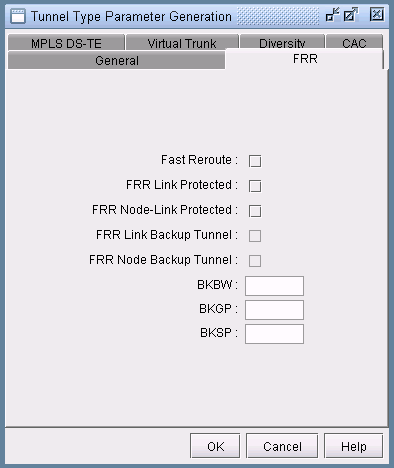Modifying Tunnels to Request FRR Protection
The following steps illustrate how to set up the network model before running an FRR Design, in case you wish to design for FRR using NorthStar Planner.
Switch to Modify mode by clicking on the “Modify” button on the main menu bar.
Go to Modify > Elements > Tunnels. In the Tunnels view pane,, select the tunnels for which you would like to add FRR protection. You can do this by either using the “Search by Property” magnifying glass icon to retrieve a subset of tunnels, or simply by highlighting the rows of interest in the main table (using <Ctrl>-click or <Shift>-click for multiple selection).
For this example, select the tunnel(s) for modification. Then, press the “Modify” button and choose “Selected Entries.”
The Modify Tunnel window will appear. Click on the “Type” button to modify the tunnel type specification. The Tunnel Type Parameter Generation window will appear. Select the FRR tab.

In the Tunnel Type Parameter Generation window, FRR tab, check off the appropriate option:
“Fast Reroute” checkbox (for Cisco FRR or for Juniper one-to-one protection)
“FRR Link Protected” or “FRR Node-Link Protected” (for Juniper many-to-one/facility protection)
Click “OK”. Notice that this merely populates the tunnel’s Type field with the word “FRR” (for Cisco) or “LP” or “NLP” for Juniper, indicating that this is a primary tunnel that is FRR-enabled. This tunnel is requesting FRR protection. You can also type this in directly in the comma-separated Type field rather than going through the Tunnel Type Parameter Generation window. Make sure that properties listed in the Type field are comma-separated, and that the Type field does not contain any spaces. For example, “R,FRR” is valid. However, “R, FRR” is not.
Click OK to close the Modify Tunnel window and make the modification.
Having made this modification, an FRR Design (described later in this chapter) can be used to automatically create either (a) FRR-Link Protection (FRR-LP) backup tunnels for each of the links that this tunnel traverses, or (b) FRR-Node Protection (FRR-NP) backup tunnels for the intermediate nodes that this tunnel traverses, depending upon whether the user selects to design for node or link protection.
